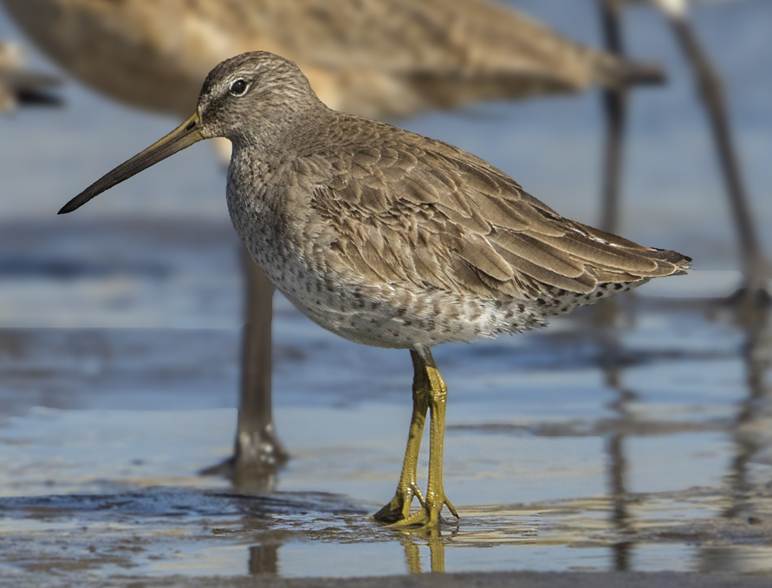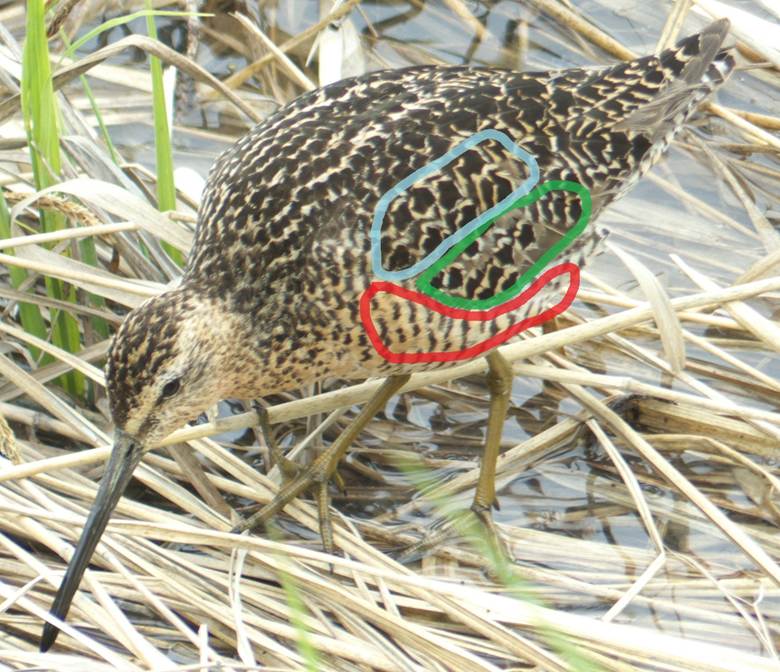Dowitchers occur in three distinct plumages – alternate
(breeding), basic (winter or non-breeding) and juvenile (young of the year).
Being able to determine the plumage of a particular dowitcher is essential as
plumage features that apply to a juvenile, for example, may not be relevant for
an adult.
Dowitchers change between plumages by going through a molt.
Molt is a process that takes some time and it should therefore come as no
surprise that birds on migration are often in active molt from one plumage to
another. Since these transitional
plumages resulting from active molt can cause identification pitfalls, I will
also give some examples of them and how to recognize them.
The photographs on this post and the next were kindly provided by Peter Schneekloth (PS), Brad Hacker (BH) and Lynn Scarlett (LS).
Basic Plumage
Dowitchers can be in in basic plumage starting from as early
as August through to April/May. Note that young birds may retain basic plumage
through the summer, but you will not see these very often in Santa Barbara
County. Basic plumage is quite distinctive from other plumages, essentially
being mostly uniform gray above (except in flight of course), and whitish below
with some spots and barring, but grayer on the breast. The two species are most
(i.e. extremely!) similar in basic plumage.
Basic-plumaged
Long-billed Dowitcher (BH)
Basic-plumaged
Short-billed Dowitcher (BH)
Alternate Plumage
Birds acquire start to acquire alternate plumage as early as March and by April many will be in mostly alternate plumage. Adult dowitchers in alternate plumage are characterized extensive reddish or orange on the underparts, which show variable, usually extensive, barring and spotting, and dark upperparts with some pale and reddish/orange feather markings mixed in. One important point to note from an aging perspective is that the feathers on the wings are generally similar to the feathers on the back and rest of the upperparts.

Alternate Long-billed Dowitcher (BH).
Note that the feather patterns of inner wing-coverts (ringed in green) and the
scapulars (ringed in turquoise) are very similar. Note the bold dark barring on
the sides of the lower breast and flanks (ringed in red).
Juvenile Plumage
Juvenile plumages are quite distinct from either of adult
plumages. Despite that, I have seen several instances where bright juvenile
Short-billed Dowitchers get confused with adults. There is a further catch as
juvenile Long-billed Dowitchers arrive rather late in migration in Santa
Barbara County and have usually started to molt into basic plumage. As a
result, they might invite confusion with basic adults. For the most part, however,
the initial molt from juvenile plumage is centered on the head, neck and
breast, while the rest of the bird remains in juvenile plumage.
If you have read any shorebird identification books, you probably know that juvenile shorebirds are “easily” aged by their “crisper” plumage due to new, unworn feathers. This is equally true of dowitchers, but inexperienced birders may not easily be able to judge whether a plumage is ‘crisp’ or not. With that in mind, I recommend a few specific plumage features you can use to identify a juvenile dowitcher plumage. You should start by looking at the underside. Even a bright juvenile Short-billed will have an orange-buff rather than orange-red tone to the underside and the orange buff in restricted to the breast and flanks, not encompassing the throat and the face as in an alternate adult dowitcher. Another underbody plumage feature to use is the presence of obvious barring on the sides of the breast or flanks. This is lacking in juvenile birds, which show fine dark streaking or spotting on the sides of the breast and flanks.
Another often useful feature is the contrast between the inner (lesser and median) wing-coverts and the scapulars.
In more layman terms, this is the contrast between the back and the wings on a
bird at rest. In adult birds, either basic or alternate, the feathers in these
two areas are generally similar to each other, creating a uniform appearance.
In juveniles, the inner (lesser and median) wing-coverts are fairly uniform
grayish with slight darker center shafts and paler edges, while the scapulars
are dark with reddish or orange markings. However, not that adults transitioning from alternate to basic can sometimes molt their coverts almost completely before shedding any scapulars, creating a similar contrast.
Juvenile Short-billed Dowitcher (BH). Note the
contrast between the solidly gray-brown (with pale edges) inner wing-coverts
(ringed in green) the scapulars that are dark with extensive buff-orange
internal markings and edges (ringed in turquoise). The underparts are buffy
washed but with short dark streaks and spots, not obvious bars. Note that the buff coloration is on the breast and flanks and does not extend on to the throat and face.
Juvenile Long-billed Dowitcher in transition to basic
(PS). Note the contrast between the gray (with dark centers) inner
wing-coverts (ringed in green) the retained juvenile scapulars that are dark
with reddish-orange internal markings and edges (ringed in turquoise). This
bird has already replaced some of the juvenile scapulars with gray basic ones,
making the contrast less obvious than in the previous Short-billed Dowitcher
photo. Note the absence of obvious barring on the underparts.
Transitional plumages
Hopefully, you are now feeling confident about identifying
the different dowitcher plumages. However, things are never quite that simple. Adult
dowitchers migrating through the county in spring and fall will frequently, if
not mostly, be in active molt between basic and alternate plumages. Birds in
active molt and look ‘messy’ as they show a mix of new, plain gray basic
feathers and worn black and orange alternate feathers. You will typically not
see juveniles in Santa Barbara County starting to extensively molt until
mid-September or later. By this time the great majority of adult birds will be
in basic plumage.
If the bird is clearly ‘in-between’ plumages, the first
point to remember is that some of the fieldmarks I will be describing may be
harder to evaluate or even unreliable. For example, an adult Long-billed
Dowitcher that is molting from alternate to basic plumage might show a lot of
white on the belly/vent, suggesting a feature of an alternate Short-billed.
However, if you have realized that the bird is in extensive molt, you can avoid
making a potential mistake. In general, birds in heavy molt are harder to
identify, so in some cases, you will need to go with dowitcher sp. unless you
can hear the bird call.
I will show a couple of pictures of transitional birds, so
you can see the effects of molt and learn to recognize it.
Short-billed Dowitcher in transition from basic to alternate plumage: Hopefully it is obvious that this bird is in heavy molt. It is a real mess with many worn basic feathers and new alternate feathers coming through. In this case, the bill is very short and too short for a Long-billed. The coloration and pattern of the edges of the incoming alternate scapulars also favor Short-billed. However, it may often be best to leave birds like this unidentified.
Adult Short-billed Dowitcher molting from alternate to
basic (LS): This bird is still largely in alternate plumage but note that
many gray basic inner wing-coverts and some scapular feathers are molting in.
Don’t let the presence of MOSTLY gray wing-coverts (ringed in green) and some
black-and-orange scapulars (ringed in turquoise) make you think this is a
juvenile. In a juvenile these feather tracts would be of a uniform pattern, not
a mix of feather patterns.







Comments
Post a Comment